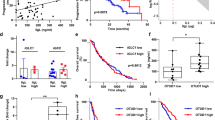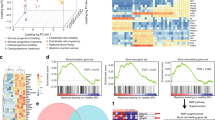Abstract
The epidermal growth factor (EGF)/EGF-receptor (ErbB1-4) family is involved in the biology of multiple myeloma (MM). In particular, ErbB-specific inhibitors induce strong apoptosis of myeloma cells (MMC) in vitro. To delineate the contribution of the 10 EGF-family ligands to the pathogenesis of MM, we have assessed their expression and biological activity. Comparing Affymetrix DNA-microarray-expression-profiles of CD138-purified plasma-cells from 65 MM-patients and 7 normal individuals to those of plasmablasts and B-cells, we found 5/10 EGF-family genes to be expressed in MMC. Neuregulin-2 and neuregulin-3 were expressed by MMC only, while neuregulin-1, amphiregulin and transforming growth factor-α were expressed by both MMC and normal plasma-cells. Using real-time polymerase chain reaction, we found HB-EGF, amphiregulin, neuregulin-1 and epiregulin to be expressed by cells from the bone marrow-environment. Only the EGF-members able to bind heparan-sulphate proteoglycans (HSPGs) – neuregulin-1, amphiregulin, HB-EGF – promote the growth of MMC. Those ligands strongly bind MMC through HSPGs. The binding and the MMC growth activity was abrogated by heparitinase, heparin or deletion of the HS-binding domain. The number of HS-binding EGF ligand molecules bound to MMC was higher than 105 molecules/cell and paralleled that of syndecan-1. Syndecan-1, the main HSPG present on MM cells, likely concentrates high levels of HS-binding-EGF-ligands at the cell membrane and facilitates ErbB-activation. Altogether, our data further identify EGF-signalling as promising target for MM-therapy.
This is a preview of subscription content, access via your institution
Access options
Subscribe to this journal
Receive 50 print issues and online access
$259.00 per year
only $5.18 per issue
Buy this article
- Purchase on Springer Link
- Instant access to full article PDF
Prices may be subject to local taxes which are calculated during checkout








Similar content being viewed by others
References
Bayer-Garner IB, Sanderson RD, Dhodapkar MV, Owens RB, Wilson CS . (2001). Mod Pathol 14: 1052–1058.
Belting M . (2003). Trends Biochem Sci 28: 145–151.
Bernfield M, Gotte M, Park PW, Reizes O, Fitzgerald ML, Lincecum J et al. (1999). Annu Rev Biochem 68: 729–777.
Borset M, Hjertner O, Yaccoby S, Epstein J, Sanderson RD . (2000). Blood 96: 2528–2536.
Carraway III KL, Weber JL, Unger MJ, Ledesma J, Yu N, Gassmann M et al. (1997). Nature 387: 512–516.
Citri A, Skaria KB, Yarden Y . (2003). Exp Cell Res 284: 54–65.
Costes V, Magen V, Legouffe E, Durand L, Baldet P, Rossi JF et al. (1999). Hum Pathol 30: 1405–1411.
Couchman JR . (2003). Nat Rev Mol Cell Biol 4: 926–937.
De Vos J, Couderc G, Tarte K, Jourdan M, Requirand G, Delteil MC et al. (2001). Blood 98: 771–780.
Derksen PW, Keehnen RM, Evers LM, van Oers MH, Spaargaren M, Pals ST . (2002). Blood 99: 1405–1410.
Dhodapkar MV, Kelly T, Theus A, Athota AB, Barlogie B, Sanderson RD . (1997). Br J Haematol 99: 368–371.
Ferlin M, Noraz N, Hertogh C, Brochier J, Taylor N, Klein B . (2000). Br J Haematol 111: 626–634.
Georgii-Hemming P, Wiklund HJ, Ljunggren O, Nilsson K . (1996). Blood 88: 2250–2258.
Goger B, Halden Y, Rek A, Mosl R, Pye D, Gallagher J et al. (2002). Biochemistry 41: 1640–1646.
Harris RC, Chung E, Coffey RJ . (2003). Exp Cell Res 284: 2–13.
Hendriks J, Planelles L, de Jong-Odding J, Hardenberg G, Pals ST, Hahne M et al. (2005). Cell Death Differ 12: 637–648.
Higashiyama S, Abraham JA, Klagsbrun M . (1993). J Cell Biol 122: 933–940.
Holbro T, Civenni G, Hynes NE . (2003). Exp Cell Res 284: 99–110.
Hynes NE, Lane HA . (2005). Nat Rev Cancer 5: 341–354.
Ingold K, Zumsteg A, Tardivel A, Huard B, Steiner QG, Cachero TG et al. (2005). J Exp Med 201: 1375–1383.
Jelinek DF, Witzig TE, Arendt BK . (1997). J Immunol 159: 487–496.
Johnson GR, Wong L . (1994). J Biol Chem 269: 27149–27154.
Karey KP, Sirbasku DA . (1988). Cancer Res 48: 4083–4092.
Kawano M, Hirano T, Matsuda T, Taga T, Horii Y, Iwato K et al. (1988). Nature 332: 83–85.
Klein B, Li XY, Lu ZY, Jourdan M, Tarte K, Brochier J et al. (1999). Curr Top Microbiol Immunol 246: 335–341.
Klein B, Tarte K, Jourdan M, Mathouk K, Moreaux J, Jourdan E et al. (2003). Int J Hematol 78: 106–113.
Klein B, Zhang XG, Jourdan M, Content J, Houssiau F, Aarden L et al. (1989). Blood 73: 517–526.
Klerk CP, Smorenburg SM, Otten HM, Lensing AW, Prins MH, Piovella F et al. (2005). J Clin Oncol 23: 2130–2135.
Kragh M, Loechel F . (2005). Int J Oncol 27: 1159–1167.
Kumar A, Loughran T, Alsina M, Durie BG, Djulbegovic B . (2003). Lancet Oncol 4: 293–304.
Liu WM, Mei R, Di X, Ryder TB, Hubbell E, Dee S et al. (2002). Bioinformatics 18: 1593–1599.
Loeb JA, Fischbach GD . (1995). J Cell Biol 130: 127–135.
Mahtouk K, Hose D, Reme T, De Vos J, Jourdan M, Moreaux J et al. (2005). Oncogene 24: 3512–3527.
Mahtouk K, Jourdan M, De Vos J, Hertogh C, Fiol G, Jourdan E et al. (2004). Blood 103: 1829–1837.
Moreaux J, Legouffe E, Jourdan E, Quittet P, Reme T, Lugagne C et al. (2004). Blood 103: 3148–3157.
Mummery RS, Rider CC . (2000). J Immunol 165: 5671–5679.
Paria BC, Elenius K, Klagsbrun M, Dey SK . (1999). Development 126: 1997–2005.
Rapraeger AC . (2000). J Cell Biol 149: 995–998.
Rebouissou C, Wijdenes J, Autissier P, Tarte K, Costes V, Liautard J et al. (1998). Blood 91: 4727–4737.
Sanderson RD, Yang Y, Suva LJ, Kelly T . (2004). Matrix Biol 23: 341–352.
Seidel C, Borset M, Hjertner O, Cao D, Abildgaard N, Hjorth-Hansen H et al. (2000a). Blood 96: 3139–3146.
Seidel C, Sundan A, Hjorth M, Turesson I, Dahl IM, Abildgaard N et al. (2000b). Blood 95: 388–392.
Su AI, Wiltshire T, Batalov S, Lapp H, Ching KA, Block D et al. (2004). Proc Natl Acad Sci USA 101: 6062–6067.
Sun RX, Lu ZY, Wijdenes J, Brochier J, Hertog C, Rossi JF et al. (1997). J Immunol Meth 205: 73–79.
Tarte K, De Vos J, Thykjaer T, Zhan F, Fiol G, Costes V et al. (2002). Blood 100: 1113–1122.
Tarte K, Fiol G, Legouffe E, Rossi JF, Klein B . (2000). Blood 96: 514a.
Van Driel M, Gunthert U, van Kessel AC, Joling P, Stauder R, Lokhorst HM et al. (2002). Leukemia 16: 135–143.
Wang YD, De Vos J, Jourdan M, Couderc G, Lu ZY, Rossi JF et al. (2002). Oncogene 21: 2584–2592.
Wijdenes J, Vooijs WC, Clement C, Post J, Morard F, Vita N et al. (1996). Br J Haematol 94: 318–323.
Zhang D, Sliwkowski MX, Mark M, Frantz G, Akita R, Sun Y et al. (1997). Proc Natl Acad Sci USA 94: 9562–9567.
Zhang XG, Gaillard JP, Robillard N, Lu ZY, Gu ZJ, Jourdan M et al. (1994). Blood 83: 3654–3663.
Acknowledgements
This work was supported by grants from the Ligue Nationale Contre le Cancer (équipe labellisée), Paris, France, and from the Association Guillaume Espoir, St Genis Laval, France.
Author information
Authors and Affiliations
Corresponding author
Rights and permissions
About this article
Cite this article
Mahtouk, K., Cremer, F., Rème, T. et al. Heparan sulphate proteoglycans are essential for the myeloma cell growth activity of EGF-family ligands in multiple myeloma. Oncogene 25, 7180–7191 (2006). https://doi.org/10.1038/sj.onc.1209699
Received:
Revised:
Accepted:
Published:
Issue Date:
DOI: https://doi.org/10.1038/sj.onc.1209699
Keywords
This article is cited by
-
The CXCL12gamma chemokine immobilized by heparan sulfate on stromal niche cells controls adhesion and mediates drug resistance in multiple myeloma
Journal of Hematology & Oncology (2021)
-
Dynamic CD138 surface expression regulates switch between myeloma growth and dissemination
Leukemia (2020)
-
Assembling custom side chains on proteoglycans to interrogate their function in living cells
Nature Communications (2020)
-
Gm40600 suppressed SP 2/0 isograft tumor by reducing Blimp1 and Xbp1 proteins
BMC Cancer (2019)
-
Syndecan-4 regulates extravillous trophoblast migration by coordinating protein kinase C activation
Scientific Reports (2019)



